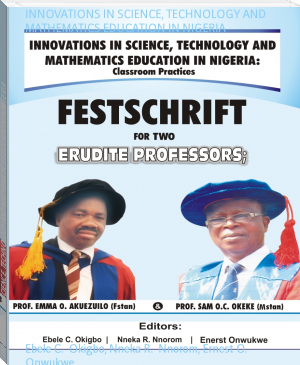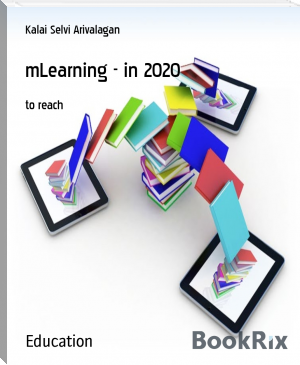INNOVATIONS IN SCIENCE, TECHNOLOGY AND MATHEMATICS EDUCATION IN NIGERIA, Ebele C. Okigbo, Nneka R. Nnorom, Ernest O. Onwukwe [best reads .TXT] 📗

- Author: Ebele C. Okigbo, Nneka R. Nnorom, Ernest O. Onwukwe
Book online «INNOVATIONS IN SCIENCE, TECHNOLOGY AND MATHEMATICS EDUCATION IN NIGERIA, Ebele C. Okigbo, Nneka R. Nnorom, Ernest O. Onwukwe [best reads .TXT] 📗». Author Ebele C. Okigbo, Nneka R. Nnorom, Ernest O. Onwukwe
Gan, G.A. (2008). Mathematics language in Nigeria’s educational system: Policy and practice. JOFRAS1, 1; 12 – 18
Hall, T.,Strangman, N.& Meyer. R. (2011). Differentiated instruction and implications for UDLimplementation. Retrieved from http/aim.cast.org/learn/historyachieve/backgroundpapers/differentiatedinstruction.
Maheshappa, M. (2013). The importance of science and mathematics in technological advancement. Retrieved from www.ncrel.org/sdrs/areas/issues/methods/technlgy/te.800html
Mckeachie, W. (2003). Teaching tips: Strategies, research and theory of College and University teachers (10thEd). Boston MA, USA: Houghton Mifflin.
Njoku, I. O. (2017). Effects of collaborative and individualized learning strategies on senior secondary school students’ achievement in Mathematics in Afikpo Education Zone. A master thesis, Nnamdi Azikiwe University, Awka, Nigeria.
Okigbo, E. C. & Okoli, J. N. (2016). Techniques used by Science, Technology and Mathematics (STM) teachers for controlling undesirable classroom behaviours in Anambra state secondary schools. Journal of the Educational Research and Review,11(11) ;1025-1034. Available at http://www.academicjournals.org/ERR
Okigbo, E. C. & Okeke, N. F. (2018). Effects of student team achievement divisions and competitive learning (immediate reinforcement) strategies on achievement of secondary school students in trigonometry. The Journal of Science Teachers Association of Nigeria, 53; 38-53.
Protheore, N. (2007). What does good mathematics instruction look like? Principal. 7(1); 51 -56.
Suchman, L. (1987). Plans and situated actions: The problem of human/machine communication.Cambridge, UK: Cambridge University Press.
Tomlinson, C.A. (2003). Deciding to teach them all. Educational Leadership, 61(2); 6-11.
EFFECTS OF CONCEPT MAPPING ON SECONDARY SCHOOL STUDENTS’ ACHIEVEMENT IN GENETICS
Eugenia N. Okafor
&
Prof. Sam O.C. Okeke
Abstract
This study investigated effects of concept mapping on students’ achievement in genetic a branch of secondary school biology. A quasi-experimental non-randomized design involving two groups was used. The two groups were experimental and control groups. A sample of 174 SSII biology students from four secondary school was involved. Two hypotheses guided the study. A Genetics Achievement Test (GAT) with reliability coefficient of 0.97 was used to measure the students’ achievement before and after treatment. Analysis of data collected was done using mean, standard deviation and independent t-Test computations. Results showed that concept mapping instructional technique was significantly effective than the conventional method, and knowledge retention was significantly higher in students taught genetics with concept mapping than those taught without use of concept mapping. The implications of these findings were discussed with relevant recommendations made.
Keywords: Concept mapping, achievement
Introduction
One of the most cited problems of teaching biology has been the use of inadequate technique for understanding difficult concepts. It arises as a result of inability of secondary school teachers’ use of concept mapping for more meaningful understanding of difficult concepts in biology by students. Students’ lack of understanding of difficult concepts in biology result to poor performance of students’ at SSCE and backwardness in the scientific and technological advancement of our nation.
Research findings have shown that a number of topics in biology amongst which is genetics contain some concepts which pose difficult for biology students (Okafor and Okeke, 2006, Nzewi 2011).
It is clear that when concepts in genetics are not meaningfully understood by
students, tend to shy away from questions arising from them during Senior Secondary
Certificate examination (SSCE). Invariably, this may lead to poor performance of
students in biology at SSCE. Results of SSCE of all the states in Nigeria from 2009
to 2015 revealed general poor percentage performance as shown below (Table1).
Table. 1: Reveals poor percentages of students with acceptable pass grades over the years.
Table1: Performance of candidates in Biology at SSCE (May/June) 2009-2015
Year
Number of Candidates that sat for SSCE
% Grades :1-6
2009
481,031
18.7
2010
508,384
11.4
2011
453,353
18.9
2012
506,628
15.9
2013
609,026
16.7
2014
625,894
34.45
Repeated reports (Chikobi 1997, Flick, 2000, Okafor and Okeke, 2006, Nwagbo and
chikelu 2011) of consistent poor performance in biology at SSCE have attracted a lot
of concern from science educators. Thus research in science Education in Nigeria
continued to seek better ways of teaching biology in order to maximize meaningful
learning, and to identify casual variables for repeated failure (Esiobu, 2000, Okafor
and Okeke 2006, Nzewi 2008, Nwagbo 2008, Nwagbo and Chikelu 2011)
In spite of efforts through research into the strategies to improve performance in
biology, The WEAC chief examiners’ yearly reports have continued to highlight
students’ weakness in answering questions relating to difficult concepts such as in the
area of genetics. Such weakness lead to students’ inability to comprehend or represent
concepts in tables, graphs and diagrams (Chief Examiner’s Report West African Examination Council 2006, 2009, 2011,2012, 2014, 2015). The use of concept mapping by teachers may enhance more meaningful understanding of difficult concepts and increase performance in biology. It has been shown that concept mapping has a great potential in enhancing students’ understanding of difficult concepts.
Concept mapping is a pedagogical strategy / metacognitive tool based on
Ausubel -Novak-Gowin theory of meaningful learning (Novak 1977; Ausubel, Novak
and Hanasian, 1978; Gowin, 1981, Novak and Gowin 1984). Concept mapping was
developed from Ausubel (1968) assimilation theory of cognitive learning. It encourages students to learn difficult concepts. It is based on the idea that meaningful learning occurs when new knowledge is consciously, explicitly and deliberately linked with relevant concepts which the leaner already knows. That is, teaching from known to unknown concepts and from concrete to abstract concepts.
Concept Mapping
Concept mapping is a technique of graphically representing concepts and their interrelationships. Concepts maps rely on three qualities, which are hierarchical structure, progressive differentiation and integrative reconciliation of meaning. In terms of hierarchical structure, lower concepts are subsumed beneath the concepts that appear in higher levels. The super-ordinate concepts are more general than the subsumed concepts. For progressive differentiation, the learner differentiates as he / she learner about the concepts. In integrative reconciliation, the learner views the relationships between the concepts as integrated concepts.
How to Construct Concept Maps
In order to construct a concept map, the mapper must be able to identify the relationship between concepts (Novak, 1984) and arrange them in a new way. The concepts are first written, using lower-case letters and are centered within circles. From the super-ordinate concepts (main concepts) at the top flow several sub-ordinate concepts with each level of the concepts increasing in specificity as it flows from top to down. All lines connecting the concepts are accompanied by link words; so that each branch of the map can be read from the top down.
Usually examples are not enclosed but they can be represented by broken circles. There may be some cross-links which show meaningful connections between one segment of the concept hierarchy and another segment. Cross links can be indicators of creative ability and integrative reconciliation of meaning (Novak, 1984).
Examples of concept maps for teaching difficult concepts in genetics as illustrated by the researchers are as follows:
A. Concept Map on Heredity, Heritable and non-heritable characters.
B. Concept Map on Nature of the gene
Concept map therefore is a schematic representation of a set of concept meanings embedded in a framework of propositions (Novak and Gowin, 1984). It provides a schematic summary of what has been learned (Novak and Gowin, 1987). Concept mapping is a tool that promotes meaningful learning as opposed to rote learning (Novak, 1984).
Studies carried out by (Novak, 1984; Okebukola, 1989, 1990, 1998; Osisioba, 1985; Okafor and Okeke, 2006, Okafor and Okeke 2018) have shown that concept mapping facilitates the learning of science concepts, promotes meaningful learning and enhances achievement.
Concept mapping as an activity based-strategy/hands-on and minds-on activities
enhances meaningful understanding of scientific concepts (Okebukola, 1992; Esiobu
and Soyibo, 1995; Okafor and Okeke, 2006; Nzewi, 2011, Okafor and Okeke 2018).
The use of concept maps by the teacher requires an active process on the part of the
teacher.
The recommendation and findings of Nzewi, 2011, Okafor and Okeke, 2018 agree with the view that one of the basic problems of biology teachers today is concerned with fostering in students productive problem solving skills as well as inculcating in them progressive differentiation of concepts and integrative, reconciliation of biological information.
Concepts mapping as one of the hands-on and minds-on activities enables the biology teacher to involve the learners at the concrete and formal operational level. Ability of students to interpret or relate information with concept map is related to their logical reasoning ability (berg and Philips, 1994; wavering, 1989).
The hierarchical order of concept mapping, integration therein as well as its
explicitness makes concept mapping an approach that concretizes abstract knowledge.
Its application therefore in linking the principles and concepts in genetics is a welcome
departure from algorithmic methods and conventional methods in solving genetics
problems.
Purpose of Study
The consistent poor performance of students in the SSCE biology entails that many prospective students will be unable to gain admission into higher institution to study biology-related courses. It is thought that the use of concept map may enhance student’s achievement in biology. The Purpose of this study therefore is to determine the effect of concept mapping on student’ achievement in genetics.
Hypotheses
The following null hypotheses were tested at P<0.5
HO1: there is no significant difference in the mean achievement scores of biology students taught genetics by use of concept map and those taught with conventional method.
HO2: there is no significant difference in the mean retention scores of biology students
taught genetics by use of concept map and of those taught with conventional method.
Methodology
For this Quasi-Experimental, four senior secondary schools were randomly selected from four Local Government Areas in Awka Education Zone of Anambra State. One hundred and seventy four (174) SSII biology students from selected schools were the sample involved in the study. The instrument for the study is a 40 item multiple choice questions: Genetics Achievement test (GAT) developed by the researchers. It was validated by four experts in science education. The KR20 (kuder Richardson formula 20) estimate of internal consistency for GAT was calculated to be 0.97.
The different multi sampled students were pre-tested prior to treatment, which scores were used to establish equivalence of the groups. After treatment, summative post-test were given the different groups of sampled students using reshuffled GAT items. A retention test of different groups of students’ was undertaken four weeks after completion of treatment using the post-test as a base to measure retention characteristics of the method. The Independent t-Test, mean and standard deviation were the statistics used in analyzing the data.
Results
Table 1: Independent t-Test comparison of mean gain scores for experimental and control groups.
Mode of instruction
No of Mean students
Mean
SD
t
df
Sig(2- Tailed) difference
Concept mapping
76
15.14
7.42
7. 81
132
.001
Conventional method
58
6.86
3.63
From table 1 above, it is observed that the mean gain scores of SSII biology students’ taught genetics using concept mapping and of those taught without use of concept mapping were 15.14 percent and 6.86 percent respectively. T. value was 7.81. While standard deviation for the two groups were 7.42 and 3.63 respectively. t-value was 7.81.
Table 2: independent t-Test comparison of mean of knowledge retention for experimental and control groups after four (4) weeks.
Mode of instruction
No of Mean students
Mean
SD
t
df
Sig(2- Tailed) difference
Concept mapping
57
47.02
14.11
4.78
96
.001
Conventional method
41
34.83
9.69
From table II above, it is observed that the mean score in knowledge retention among biology students taught genetics by use of concept mapping is 47.02 and 34.83 for those taught without the use concept mapping. T-value was 4.78.
Discussion of result
From the result of the study, it is apparent that the mean gain academic achievement of the SSII biology students taught genetics using concept mapping and of those taught without the use of concept mapping are 15.14 and 6.86 percent respectively. While t-value is 7.81. The results showed that application of concept mapping significantly facilitated better understanding of difficult concepts and reduced learning difficulties in genetics for experimental group than for control group. It is also clear from the result that the mean achievement score in knowledge retention among biology students taught genetics by use of concept mapping is 47.02 and 34.83 for those taught without use of concept mapping. While t-value is 4.78. The results showed significant higher retention ability of biology students’ taught genetics with concept mapping than those taught without the use of concept mapping.
The reason for higher knowledge retention ability for the experimental group than for the control group is that use of concept mapping reduced students’





Comments (0)